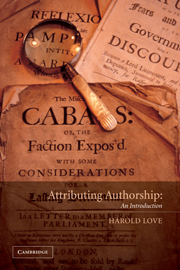Book contents
- Frontmatter
- Contents
- Acknowledgements
- List of abbreviations
- Introduction
- 1 Individuality and sameness
- 2 Historical survey
- 3 Defining authorship
- 4 External evidence
- 5 Internal evidence
- 6 Stylistic evidence
- 7 Gender and authorship
- 8 Craft and science
- 9 Bibliographical evidence
- 10 Forgery and attribution
- 11 Shakespeare and Co.
- 12 Arguing attribution
- Notes
- Select bibliography
- Index
9 - Bibliographical evidence
Published online by Cambridge University Press: 22 September 2009
- Frontmatter
- Contents
- Acknowledgements
- List of abbreviations
- Introduction
- 1 Individuality and sameness
- 2 Historical survey
- 3 Defining authorship
- 4 External evidence
- 5 Internal evidence
- 6 Stylistic evidence
- 7 Gender and authorship
- 8 Craft and science
- 9 Bibliographical evidence
- 10 Forgery and attribution
- 11 Shakespeare and Co.
- 12 Arguing attribution
- Notes
- Select bibliography
- Index
Summary
No one would wish to venture very far into attribution studies without an acquaintance with the specialist disciplines loosely linked under the rubric ‘textual criticism and bibliography’. Codicologists, palaeographers and descriptive bibliographers study aspects of the material records used to transmit texts and the ever-changing forms of the signs inscribed on them but without concerning themselves more than necessary with the meaning of those signs. Textual bibliographers study the relationship between physical manufacture and semantic change. Stemmatologists analyse verbal variants between sources in order to determine the direction of transmission. Historians of the book contextualise the work within contemporaneous cultures of authorship, book-manufacture, distribution and reception. Scholarly editors have to be able to do all of these things.
Each of these specialisms has vital information to offer attributionists. Each also has a large professional literature to which entry may be obtained through introductory texts such as Philip Gaskell's A New Introduction to Bibliography (1972), David Greetham's Textual Scholarship: An Introduction (1992), Peter Davison's collection The Book Encompassed: Studies in Twentieth-century Bibliography (1992) and Geoffrey Glaister's Encyclopedia of the Book, 2nd edn (1996). For handwriting one might begin with Anthony G. Petti's English Literary Hands from Chaucer to Dryden before proceeding to more specialised studies such as Michael Finlay's Western Writing Implements in the Age of the Quill Pen and Tom Davis's ‘The analysis of handwriting: an introductory survey’ which summarises contemporary forensic methods.
- Type
- Chapter
- Information
- Attributing AuthorshipAn Introduction, pp. 163 - 178Publisher: Cambridge University PressPrint publication year: 2002

